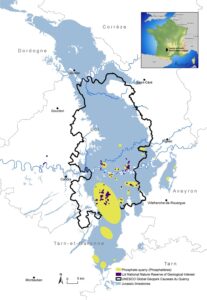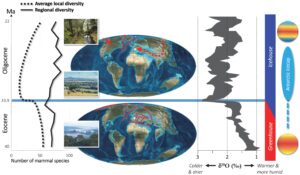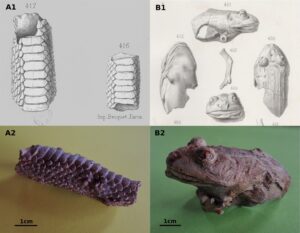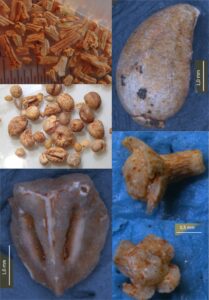Introduction
The Causses du Quercy provide nearly 200 paleontological localities that document the ‘Grande Coupure’, an important biological crisis driven by climatic and paleogeographic changes at the Eocene–Oligocene transition, 33.9 million years ago (Ma). This event is marked by drastic changes in climatic and environmental conditions as well as biodiversity. The Geopark is located in southwestern France, on the northern sedimentary edge of the Aquitaine, a site of former phosphate mining on the southern termination of the Causses du Quercy, straddling the Lot and Tarn-et-Garonne departments, with a few sites also in the Aveyron and Tarn departments (Fig. 1). They occupy the southern half of the territory of the UNESCO Causses du Quercy World Geopark.

Figure 1. Geographical location and geological context of the Causses du Quercy area in southwestern France.
The key importance of the site includes its documentation of the Grand Coupure, which was enabled by three other elements.
First, the Jurassic carbonate substratum has experienced karstic erosion since the Campanian–Maastrichtian, about 70 Ma. Limited surface weathering since then means that paleokarstic fillings of very different ages, ranging from 52 Ma to the present, may be seen, including a continuous, highly fossiliferous series from the late middle Eocene to the late Oligocene (39–24 Ma).
Second, the karstic cavities form sedimentary traps and specific habitats. The remains of living organisms accumulated in the caves, whatever their size: large elements brought by floods, prey dragged into their dens by predators, pellets of raptors, corpses of cave-dwellers, etc. The filling was instantaneous geologically speaking, and fossils thus give a relatively accurate and unbiased picture of the ecosystems around the landscape above the karst.
Third, phosphate is omnipresent in these fillings. Even if the mechanisms, probably bacterial, allowing its mobilization remain poorly understood, they allowed flash fossilization of exceptional quality. This is evidenced by the preservation of skulls in 3D (especially as delicate as those of bats) and the presence of amphibian mummies, mummified arthropods, and phosphatized seeds, fruits and flowers.
Scientific Importance of the Causses du Quercy Geopark
The Causses du Quercy Geopark has no equivalent worldwide in preserving a unique abundance of highly fossiliferous paleokarst (a multi-site Konzentrat-Lagerstätte) recording local fossil assemblages covering a total time interval of more than 30 million years (52–19 Ma) among which ca. 15 myr is very densely documented (39–24 Ma) with excellent biochronological resolution (Escarguel et al. 1997) in a context of drastic global climatic and environmental changes.
The dense, almost continuous fossil record at Quercy gives access to a dynamic image of vertebrate faunas (Fig. 2), with an unparalleled taxonomic diversity of amphibians (frogs and newts), squamates (lizards and snakes), turtles, crocodilians, birds (with for example parrots and birds of prey), and, above all, mammals, including marsupials, pangolins, flesh-eaters, insectivores, odd- and even-toed ungulates, bats, rodents, and primates (Pélissié and Sigé 2006). Hence, this fossil assemblage offers a unique window on Eocene–Oligocene biodiversity in Europe (Legendre 1989; Escarguel et al. 2008, 2011).

Figure 2. Selected Eocene–Oligocene phosphatized fossils and life reconstructions from the Causses du Quercy Geopark. A) Screen-washing residue of the new Dams locality, latest Eocene. B) Skull of the small primate Microchoerus eracinus showing the molding of its cranial cavity, latest Eocene. C) Life reconstruction of the late Eocene artiodactyl Mouillacitherium elegans, named after the local Mouillac village. Reconstructions by Maëva J. Orliac. D) Bat petrosal bones from Sainte Néboule locality, late Eocene. E) Life reconstruction of the early Oligocene hipposiderid bat Vaylatsia, named after the local Vaylats village Reconstruction by Maëva J. Orliac. F) Skull of the late Eocene–earliest Oligocene theridomorph rodent Suevosciurus, a genus known from several fossil localities in the Quercy before and after the 'Grande Coupure'. Scale bars = 5 cm (A), 1 cm (B, C), 5 mm (D, F).
Most remarkably, the time interval covered by the Quercy localities includes a major global climate aridification and cooling event at the Eocene–Oligocene transition (EOT). This event relates to the onset of an Antarctic icecap in response to the slow decrease in atmospheric CO2 concentration during the late Eocene combined with the opening of the Drake Passage by the latest Eocene (Zachos et al., 2008). Beyond the geologically abrupt switch from a Greenhouse to an Icehouse Earth, such a global climate change has profound biogeographical consequences following a major drop in sea level worldwide resulting from the onset of ice sheets. In Eurasia, the EOT thus corresponds to a major faunal turnover called the ‘Grande Coupure’ (Stehlin 1910), where about half the European placental mammal species disappeared, while many clades of Asian or North American origin immigrate (Legendre and Hartenberger 1992).
In this context, the Quercy fossil record offers a unique integrated perspective on the deep-time local to regional evolutionary and ecological dynamics of vertebrate communities in the context of a global crisis. For instance, Legendre (1989) and Escarguel et al. (2008) show through cenogram analyses how the EOT deeply affected local mammal communities from both taxonomic composition and richness points of view, whereas Escarguel et al. (2008, 2011) showed an entirely distinct impact of the EOT at the regional metacommunity level (Fig. 3). Focusing on late Eocene and early Oligocene even-toed ungulates for which a comprehensive fossil record is available from the Quercy localities, the ongoing “Deadender” research project led by one of us (MJO), and funded by the ANR, aims to characterize and contrast the biological characteristics and evolutionary dynamics of European endemic 'archaic' Eocene clades and Asian 'modern' clades which dispersed into Europe during the ‘Grande Coupure’.

Figure 3. Fossil localities from the Causses du Quercy Geopark illustrate the deep-time evolutionary and biodiversity dynamics of terrestrial environments in a geographically and climatically changing world. The blue line at 33.9 Ma (Eocene-Oligocene transition) indicates Stehlin's 'Grande Coupure', a major Northern-hemisphere biogeographical event resulting from the onset of an Antarctic icecap in the context of a Greenhouse to Icehouse global climate change. The white star on the paleomaps locates the Causses du Quercy area. Evolution of the local and regional number of mammal species after Escarguel et al. (2008); Paleomaps by Ron Blakey 2016; б18O curve and global climate after Zachos et al. (2008).
In addition to vertebrates, the Quercy localities also yield invertebrate and plants remains, enhancing the value of the sites in providing snapshots of past terrestrial ecosystems. Insects, plants, and some amphibians are preserved as “phosphatized mummies”, with finest details and soft body parts, resulting from a rapid permineralization process that remains to be elucidated. These exceptionally preserved past organisms are very rare worldwide, especially for this time interval.
Although 3D batrachian remains (Fig. 4) were mentioned and depicted in very early years (Filhol 1873), their real nature, as simple molds or mummies, was long debated. It was not until the use of CT Scan- and Synchrotron-aided imagery (Laloy et al. 2013; Tissier et al. 2016) that the question was settled. Three-dimensional tissue preservation is truly outstanding in some cases: a Phosphotriton sigei salamander preserves the lungs, spinal cord, muscles, urogenital organs, and digestive tract. In the latter organ, the perfectly identifiable remains of a frog, further testify to the animal's last meal. This is the oldest known example of 3D preservation of vertebrate internal organs to date (Tissier et al. 2017).

Figure 4. Squamate mummies from the Causses du Quercy Global Geopark. A) Coluber sp. B) Thaumastosaurus gezei. A1, B1, drawings published by Filhol (1873). A2, B2, moldings made by the MNHN Paris.
Insect remains have also been reported for a long time. For instance, Thévenin (1903) wrote "The insects, which are quite numerous in phosphorites and often very delicately preserved, would deserve special study". This task was initiated four decades later (Handschin 1944) with a remarkable apprehension of internal structures of pupae through progressive wear and tear. Once again, recent investigation methods using high-energy scanners opened new lines of investigation, notably in unveiling early examples of parasitism in arthropods (Schwermann et al. 2016 a,b; van de Kamp et al. 2018). Nevertheless, if the data until now have been investigated from undated old collections, recent field work has revealed several well-identified and biochronologically-constrained localities that yield such phosphatized mummies (Fig. 5).

Figure 5. Arthropod mummies from the Causses du Quercy Global Geopark. Top line: beetles; middle line, myriapods; bottom line, undetermined insects.
The presence of plant remains in the Quercy localities was only explicitly mentioned in the last decades (De Franceschi et al. 2006). The diversity of wood fragments, buds, seeds, and fruits is considerable (Fig. 6), with each field season bringing numerous new specimens. All these fascinating discoveries open up new research avenues for the phosphorites of Quercy.
Figure 6. Vegetal remains from the Causses du Quercy Global Geopark. A) Fragments of branches. B1 to 3) Various seeds. C) Bud in lateral (1) and apical view (2).
Thousands of spectacular fossils were discovered during the intense mining activity for phosphate exploitation in the second half of the 19th century and bought by museums. Fossils from Quercy are today curated by major museums around the world, such as the Muséum National d’Histoire Naturelle in Paris (20,000 specimens), the Natural History Museum in London, and the American Museum of Natural History in New York. From 1965, paleontological fieldwork at Quercy by academics from various French institutions led to the collection of over 100,000 referenced specimens (actually, several millions, if the fragmented and unnumbered elements are taken into account) in well-constrained stratigraphic, biochronological and taphonomic contexts. Rich in about 500 mammalian fossil species described to date for nearly 700 vertebrate species, the Quercy mammalian paleofauna now unsurprisingly constitutes a worldwide Paleogene reference, with five European Mammalian Paleogene reference levels (MP) defined after localities situated in the Quercy area, including three from the Causses du Quercy Geopark (BiochroM’97 1997).
Given the exceptional geographical and temporal density of its highly fossiliferous localities, the Causses du Quercy Geopark can barely be compared to other fossil-yielding areas around the world. In France, no region among the most fossiliferous (e.g., Eastern Occitania or the Paris Basin) offers such a quantity and quality of fossil record over such a long period of time. In Europe, the fossil-bearing levels of the Geiseltal coal mines in Saxony-Anhalt, Germany, have provided a magnificent fossil record, including hundreds of complete vertebrate skeletons, covering a much shorter, mid-Eocene time interval (48–42 Ma). Nevertheless, these fossiliferous levels are no longer accessible, the entire pit mine having been flooded by a large artificial lake in the 2000s to create recreational and natural areas. On the other hand, the Madrid, Calatayud-Daroca and Teruel sedimentary basins in Central Spain offer an impressive but size-biased micro-vertebrate fossil record spanning ca. 20 myr from the latest Oligocene to the early Pliocene, but here scattered over a much larger and composite geographical area than in Quercy. Outside Europe, the Cretaceous-Paleogene sedimentary basins in the northwestern USA (e.g., the Bighorn Basin in Wyoming) as well as the Mongolian Plateau in Asia provide outstanding vertebrate fossil records through hundreds of fossiliferous localities over longer time intervals than for the Quercy, but these records do not offer the spatiotemporal density achieved in the Quercy area.
The fossiliferous complex most directly comparable to the Causses du Quercy Geopark in terms of quality, quantity and density of fossils and fossil localities is the Riversleigh UNESCO World Heritage area in NW Queensland, NE Australia (Archer et al. 2000). Fossil sites at Riversleigh document freshwater limestones deposited in lime-rich pools as well as cave and fissure-filling deposits. The Riversleigh vertebrate fauna includes exquisitely preserved fossils of monotreme and marsupial mammals as well as birds and reptiles from about 200 fossil localities ranging from the late Oligocene to the late Miocene (ca. 25–5 Ma). Beyond obvious faunal differences between Europe and Australia, the main difference between the Causses du Quercy Geopark and the Riversleigh World Heritage area is the surface occupied by the Australian sites, about 100 km², thus preventing the integration of local biodiversity variations at an ecologically and evolutionarily relevant regional scale.
Geotouristic Valorization of the “Phosphatières”
Over the last decade, many nations have become interested in geotourism. With the UNESCO World Geopark label obtained in 2017, the Causses du Quercy Regional Natural Park wanted to give genuine recognition to its geological heritage, of which phosphate deposits are the jewel in the crown. However, the Causses du Quercy did not wait until this label was obtained to promote some of its geosites and to make them accessible to the public. At the initiative of various public or private players, four phosphate deposits have been developed and interpreted.
(a) Guided tour of the Cloup d'Aural phosphatières. Developed and managed by the Quercy Phosphate Association, they opened to the public in 2000. This tourist site offers visitors the opportunity to descend, via a comfortable path, to the bottom of a phosphatière, the visit being guided. Excavations are organized every summer in the surrounding phosphatières; the Cloup d'Aural is then the base camp for processing these localities (room made available for screenwashing, sieving, and picking fossil remains under a battery of stereomicroscopes). With 14,000 annual visitors, the Cloup d'Aural phosphatières are a geosite actively participating in the economic development of southern Lot with four permanent jobs. It is the fifth most visited natural cavity (behind the Padirac chasm and the Pech Merle caves) in the Lot Departement. Since 2019, the community of communes of the Pays de Lalbenque-Limogne has taken over the management and tourist exploitation of this unique site. It is currently the subject of an ambitious four-year program to upgrade the site's tourist facilities to extend the visitor route and improve the experience on the one hand, and to strengthen the surface interpretation facilities on the other.
- b) Free access to the phosphatières des Tempories. In addition to the Cloup d'Aural phosphate quarries, the Parc naturel régional des Causses du Quercy, in conjunction with the local authorities, wanted to develop freely accessible phosphatières. The Geosite of Tempories, which still contains some traces of its mining operations, was selected for this project. This choice was motivated by the fact that it is a reference paleontological geosite whose fillings were dated at 34.4 Ma, i.e. just before the ‘Grande Coupure’. The approach to the phosphatières has been secured and observation platforms have been installed. In addition, an interpretation panel presents the site.
- c) Phosphate mound and caving at the Factor's igue. This atypical geosite provides access to
- d) The karstic path of Crégols. In partnership with speleologists, an interpretation trail has been created on the theme of water catchments in limestone environments. It integrates the Crégols phosphatière which, in addition to its interest as an aquifer resource, illustrates the conservation role of karst.
Conservation of Phosphatières-related Geopatrimony
The phosphatières located within the perimeter of the Causses du Quercy Regional Nature Park benefit from double protection.
First is classification as a National Geological Nature Reserve. This classification, initiated by the French State in 2015, provides strong protection and is endowed with dedicated funding and human resources. Any geosite sampling is subject to authorization following the advice of a dedicated Scientific Council. Whatever their nature, dumping of waste is strictly forbidden. The agents of the Reserve have police powers, but their work includes above all an important information and awareness-raising component aimed at the inhabitants and users of the territory, local elected representatives, tourists, and especially schoolchildren. In parallel, the Reserve coordinates the ongoing scientific research activities in the phosphatières and indexes in its collection of all the specimens collected.
Older collections were built up during the industrial exploitation of these sites at the end of the 19th century and during excavations prior to its creation. The Reserve endeavors to complete an exhaustive inventory, but this is a difficult task, as fossils are scattered in numerous public and private collections all over the world. In the long term, it is planned to archive as many CT scans as possible of the major specimens, particularly holotype and figured specimens, to produce 3D prints of them and to enhance their value through a museographical structure set up, with the Maison de la Réserve on the Cloup d'Aural site.
A second level of protection comes through the GGU label of the Causses du Quercy. This is intended to enable the inhabitants to better appropriate this still little-known heritage and to become its guarantors (Fig. 7). They are closely linked to the projects carried out by the GGU, often in partnership with approved structures such as the Cloup d'Aural geosite and the "Les phosphatières du Quercy" association. For schools, we note the "Graines de paléontologues" (seeds of palaeontologists) program, in which fossiliferous sediment is handed over to the schools that sort it, with all the fossils collected in this way enriching the material available to paleontologists (Peigné et al. 2014). For its part, the operation "My village, my fossil" aims to create, in consultation with the inhabitants, a mascot promoting extinct animals whose name derives from that of the village, such as Bachitherium for Bach or Vaylatsia for Vaylats (Fig. 2).
The boundaries of the Geopark are currently limited to the Lot Department, and some phosphate quarries, particularly in the Tarn-et-Garonne Department, are excluded. Contacts with local elected officials are underway for a possible extension of the Reserve, or even the Geopark in the long term, to ensure sustainable conservation.

Figure 7. On the Cloup d'Aural geosite, each year, more than 14.000 adults and children discover the "Phosphatières du Quercy" through specific animations.
Summary
Since their discovery in the 1870s, the Phosphatières du Quercy has never ceased to provide abundant and diverse Paleogene fossil material including vertebrates, molluscs, arthropods, and plant remains. After a few decades of relative oblivion following the abandonment of mining activities in the early 20th century, the renewal of modern paleontological research in the Causses du Quercy in the mid-1960s, which has been uninterrupted ever since, has demonstrated the extreme richness of the Quercy fossil-yielding sites, combined with the exceptional preservation of very delicate specimens (e.g., bat and rodent skulls, petrosal and middle-ear bones) as well as “mummified” organisms preserving petrified soft tissues. This makes Quercy one of the most exceptional fossil-yielding areas at the world scale – a genuine multi-site Konzentrat-Lagerstätte including about 200 fossil localities known to date. New localities are discovered and sampled every year, and thoroughly associated with the geological and sedimentological study of fossiliferous fillings. As such, the Phosphatières du Quercy allow for a diachronic analysis of local-regional terrestrial communities, their dynamics, and their environment over more than 15 myr, in a context of major climatic and biogeographical changes (around the Eocene-Oligocene transition).
Building on previous scientific results and ongoing research projects, the long-term scientific potential of this area is indisputable and future studies of fauna and flora dynamics will certainly be of considerable help for understanding the evolution of organisms during times of drastic global changes. Forthcoming projects may tackle questions related to absolute radiometric dating of fossils and sediments to improve the biochronological resolution of the entire time series, karst dynamics and phosphatization processes. On the other hand, focusing on specific, well-sampled clades or trophic levels will provide a more detailed understanding of the evolutionary and ecological dynamics of inter-organismal interactions in the ancient ecosystems.
Concerning land development, a Reserve House will be created on the Cloup d'Aural site, a phosphatière-museum open to the public since 2000. This structure devoted to the reserve and the geopark will include a conservation area for the collections (currently scattered in different academic institutions) and a public-dedicated museographic structure, part of which will be outdoors. A series of short video presentations about the geosites has already been initiated (https://www.facebook.com/parcdescaussesduquercy/videos/331979104694995) and will be expanded. These actions result from the constant desire to involve the inhabitants in the management of a geo-heritage unique in the world.
Conflict of Interest
The authors declare that they have no conflicts of interest concerning this article
